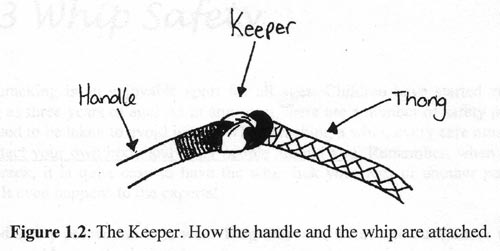Stock Whip Design
To successfully master the art cracking, a person must first understand exactly what makes a whip crack.
The
noise of the whip cracking is produced when the whip is moved through
the air in such a way as to cause the Cracker to break the sound
barrier.
To break the sound barrier, the whip must travel in excess of 343 meters/second.
Many people first assume that the whip cracks when it hits the ground - this, however, is incorrect.
The factors that make a whip break the sound barrier are:
- The shape of the whip
- The direction that the whip moves in
- The speed of the whip.

Figure 1.1 depicts the shape of the Stockwhip
A
Stockwhip is made up of the Handle (or Stock), the Thong (the plaited
part), the Fall (a single strip of leather) and the Cracker.
The Handle is attached to the Whip by a section called the Keeper.
This connection is shown in Figure 1.2

The
Handle has a loop of leather attached to the end of it (the dark
coloured section in the diagram), and the Thong is started with a loop
of leather (the light coloured section in the diagram).
The Handle is
fed through the loop of the Thong and the Thong is fed through the loop
of the Handle so that they become attached as in Figure 1.2 above.
As you can see in Figure 1.1, the Whip is shaped in a tapering fashion.
The amount of taper, the thickness and length of the Thong varies from Whip to Whip and from Whip Maker to Whip Maker.
A single piece of leather is the attached to the end of the Thong.
This is known as the Fall.
The Fall is is a replaceable part of the Whip and is the section that will take the most wear and tear.
Attached to the Fall is the Cracker.
This is the part of the Whip that finallt breaks the sound barrier and produces the cracking noise.
Crackers require frequent replacement.
The shape, length, thickness and material used for the Cracker produce different cracking tones when breaking the sound barrier.
The
Whip breaks the sound barrier because as it is swung, we exert a force
from handle and energy is transferred along the length of the whip.
Because
the whip is tapered from thick to thin, the Kinetic Energy flowing
along the Whip causes the loop created to travel faster and faster
until, when it reaches the Cracker, the loop is traveling in excess of
343 meter/second and creates a small sonic boom - the cracking sound
that we hear.
It is believed that the first time Humans broke the sound barrier was by cracking a Whip.
The force required from the person holding the Whip is very minimal to make it crack.
It only requires a change of direction of the Whip or a change in speed.
The techniques used to do this are shown on other parts of this website.
Reprinted with kind permission of Angie Mooney




